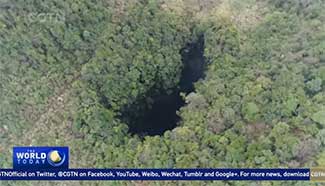SAN FRANCISCO, March 27 (Xinhua) -- Researchers at Stanford University have analyzed 27 past and ongoing examples in 22 countries of attempts to implement "managed retreat," and tried to help policymakers decide whether and how to push forward the strategy.
The "managed retreat" means relocation or abandonment of development in the face of extreme weather risks.
"People will be on the move in a changing climate," said Katharine Mach, a senior research scientist in Stanford's School of Earth, Energy & Environmental Sciences and co-author of a study released Monday. "We can respond in a managed, strategic way or in a way that is just fleeing disaster."
Last year, the United States alone suffered 15 natural disasters that each caused 1 billion dollars or more in damage, according to the U.S. National Oceanic and Atmospheric Administration (NOAA).
Coastal communities threatened by sea level rise and heavy storms are particularly hard hit.
And according to a 2011 study, sea level rise could displace nearly 190 million people by the end of the century around the world.
"Many people have an apocalyptic vision of what managed retreat means -- ripping people out of their homes and letting buildings fall into the sea," said lead author Miyuki Hino, a doctoral student in the Emmett Interdisciplinary Program in Environment and Resources. "In fact, there can be a huge potential benefit for the economy and for communities leaving the past behind and going to a better place. Still, it won't be the right solution for everyone."
However, the researchers noted, relocating communities and abandoning at-risk structures might make sense on paper, but the social, cultural and psychological obstacles can be insurmountable.
The strategy is also less likely to find buy-in where structural protections such as sea walls and levees are in place.
On the other hand, relocation can preserve community networks and culture. "We know change is coming, and there won't be a one-size-fits-all solution for protecting and supporting communities at risk," Hino said.
With analysis of the past and ongoing examples of attempts to implement managed retreat, the researchers created a conceptual model based on who benefits from retreat and who initiates it.
They categorized the examples with one of four labels based on whether residents initiated the retreat and how much support they got from the party that would be implementing the move through buy-outs, infrastructure changes or other financial support.
These labels group similar cases, such as when the residents initiate the retreat and receive government buyouts of high-risk properties.
Other groupings include cases where residents don't initiate the retreat, but, because of the greater good to the region, the government buys or elevates homes and creates a floodplain to protect downstream communities.
In a third grouping, the residents did initiate retreat but failed to gain support of the government to implement the move.
Hino and her co-authors found that relocation is most likely to occur when residents feel the environmental risks are intolerable, the retreat benefits broader society in some way, political will for retreat is high and a societal cost-benefit ratio justifies the move -- a scenario they labeled "mutual agreement."
By contrast, managed retreat rarely works when the benefits of retreat accrue to residents only or no one at all, or when political will is low and a societal cost-benefit ratio doesn't justify relocation -- a scenario they labelled "hunkered down."
While rare, instances of communities voluntarily acting before disaster strikes could shed light on how to get past various barriers to the approach, the researchers said, suggesting that policymakers should support community ownership of the relocation process, from selecting the resettlement location to designing its infrastructure.
"It makes sense to keep a range of options, including managed retreat, on the table," Hino was quoted as saying in a news release.












